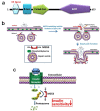Dual function of MG53 in membrane repair and insulin signaling
- PMID: 27174502
- PMCID: PMC5070728
- DOI: 10.5483/bmbrep.2016.49.8.079
Dual function of MG53 in membrane repair and insulin signaling
Abstract
MG53 is a member of the TRIM-family protein that acts as a key component of the cell membrane repair machinery. MG53 is also an E3-ligase that ubiquinates insulin receptor substrate-1 and controls insulin signaling in skeletal muscle cells. Since its discovery in 2009, research efforts have been devoted to translate this basic discovery into clinical applications in human degenerative and metabolic diseases. This review article highlights the dual function of MG53 in cell membrane repair and insulin signaling, the mechanism that underlies the control of MG53 function, and the therapeutic value of targeting MG53 function in regenerative medicine. [BMB Reports 2016; 49(8): 414-423].
Figures

Similar articles
-
MG53-IRS-1 (Mitsugumin 53-Insulin Receptor Substrate-1) Interaction Disruptor Sensitizes Insulin Signaling in Skeletal Muscle.J Biol Chem. 2016 Dec 23;291(52):26627-26635. doi: 10.1074/jbc.M116.754424. Epub 2016 Nov 3. J Biol Chem. 2016. PMID: 27810898 Free PMC article.
-
MG53 is not a critical regulator of insulin signaling pathway in skeletal muscle.PLoS One. 2021 Feb 10;16(2):e0245179. doi: 10.1371/journal.pone.0245179. eCollection 2021. PLoS One. 2021. PMID: 33566837 Free PMC article.
-
Zinc Binding to MG53 Protein Facilitates Repair of Injury to Cell Membranes.J Biol Chem. 2015 May 29;290(22):13830-9. doi: 10.1074/jbc.M114.620690. Epub 2015 Apr 13. J Biol Chem. 2015. PMID: 25869134 Free PMC article.
-
MG53 is a double-edged sword for human diseases.Sheng Li Xue Bao. 2016 Aug 25;68(4):505-16. Sheng Li Xue Bao. 2016. PMID: 27546510 Review.
-
Is MG53 a potential therapeutic target for cancer?Front Endocrinol (Lausanne). 2023 Nov 15;14:1295349. doi: 10.3389/fendo.2023.1295349. eCollection 2023. Front Endocrinol (Lausanne). 2023. PMID: 38033997 Free PMC article. Review.
Cited by
-
Sustained elevation of MG53 in the bloodstream increases tissue regenerative capacity without compromising metabolic function.Nat Commun. 2019 Oct 11;10(1):4659. doi: 10.1038/s41467-019-12483-0. Nat Commun. 2019. PMID: 31604915 Free PMC article.
-
MG53 protects against contrast-induced acute kidney injury by reducing cell membrane damage and apoptosis.Acta Pharmacol Sin. 2020 Nov;41(11):1457-1464. doi: 10.1038/s41401-020-0420-8. Epub 2020 May 18. Acta Pharmacol Sin. 2020. PMID: 32424239 Free PMC article.
-
MG53 anchored by dysferlin to cell membrane reduces hepatocyte apoptosis which induced by ischaemia/reperfusion injury in vivo and in vitro.J Cell Mol Med. 2017 Oct;21(10):2503-2513. doi: 10.1111/jcmm.13171. Epub 2017 Apr 12. J Cell Mol Med. 2017. PMID: 28401647 Free PMC article.
-
MG53-IRS-1 (Mitsugumin 53-Insulin Receptor Substrate-1) Interaction Disruptor Sensitizes Insulin Signaling in Skeletal Muscle.J Biol Chem. 2016 Dec 23;291(52):26627-26635. doi: 10.1074/jbc.M116.754424. Epub 2016 Nov 3. J Biol Chem. 2016. PMID: 27810898 Free PMC article.
-
Association of MG53 with presence of type 2 diabetes mellitus, glycemic control, and diabetic complications.PLoS One. 2023 Sep 12;18(9):e0291333. doi: 10.1371/journal.pone.0291333. eCollection 2023. PLoS One. 2023. PMID: 37699054 Free PMC article.
References
Publication types
MeSH terms
Substances
Grants and funding
LinkOut - more resources
Full Text Sources
Other Literature Sources
Medical

